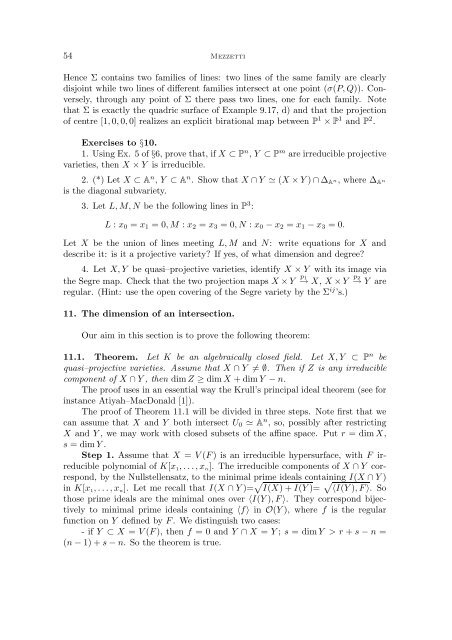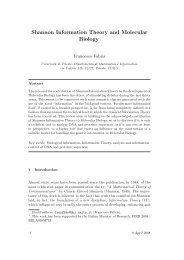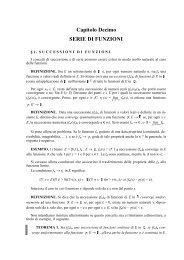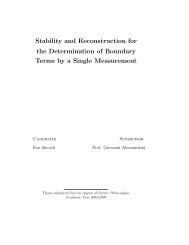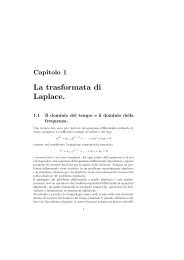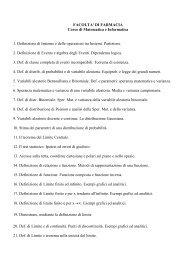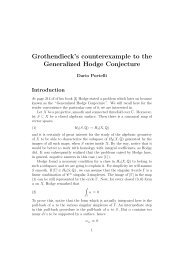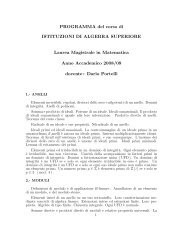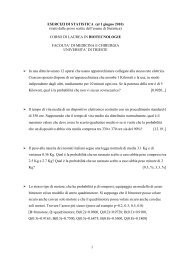INTRODUCTION TO ALGEBRAIC GEOMETRY Note del corso di ...
INTRODUCTION TO ALGEBRAIC GEOMETRY Note del corso di ...
INTRODUCTION TO ALGEBRAIC GEOMETRY Note del corso di ...
You also want an ePaper? Increase the reach of your titles
YUMPU automatically turns print PDFs into web optimized ePapers that Google loves.
54 MezzettiHence Σ contains two families of lines: two lines of the same family are clearly<strong>di</strong>sjoint while two lines of <strong>di</strong>fferent families intersect at one point (σ(P, Q)). Conversely,through any point of Σ there pass two lines, one for each family. <strong>Note</strong>that Σ is exactly the quadric surface of Example 9.17, d) and that the projectionof centre [1, 0, 0, 0] realizes an explicit birational map between P 1 × P 1 and P 2 .Exercises to §10.1. Using Ex. 5 of §6, prove that, if X ⊂ P n , Y ⊂ P m are irreducible projectivevarieties, then X × Y is irreducible.2. (*) Let X ⊂ A n , Y ⊂ A n . Show that X ∩ Y ≃ (X × Y ) ∩ ∆ A n, where ∆ Anis the <strong>di</strong>agonal subvariety.3. Let L, M, N be the following lines in P 3 :L : x 0 = x 1 = 0, M : x 2 = x 3 = 0, N : x 0 − x 2 = x 1 − x 3 = 0.Let X be the union of lines meeting L, M and N: write equations for X anddescribe it: is it a projective variety? If yes, of what <strong>di</strong>mension and degree?4. Let X, Y be quasi–projective varieties, identify X × Y with its image viathe Segre map. Check that the two projection maps X ×Y p 1→ X, X ×Y p 2→ Y areregular. (Hint: use the open covering of the Segre variety by the Σ ij ’s.)11. The <strong>di</strong>mension of an intersection.Our aim in this section is to prove the following theorem:11.1. Theorem. Let K be an algebraically closed field. Let X, Y ⊂ P n bequasi–projective varieties. Assume that X ∩ Y ≠ ∅. Then if Z is any irreduciblecomponent of X ∩ Y , then <strong>di</strong>mZ ≥ <strong>di</strong>m X + <strong>di</strong>m Y − n.The proof uses in an essential way the Krull’s principal ideal theorem (see forinstance Atiyah–MacDonald [1]).The proof of Theorem 11.1 will be <strong>di</strong>vided in three steps. <strong>Note</strong> first that wecan assume that X and Y both intersect U 0 ≃ A n , so, possibly after restrictingX and Y , we may work with closed subsets of the affine space. Put r = <strong>di</strong>m X,s = <strong>di</strong>m Y .Step 1. Assume that X = V (F) is an irreducible hypersurface, with F irreduciblepolynomial of K[x 1 , . . ., x n ]. The irreducible components of X ∩ Y correspond,by the Nullstellensatz, to the minimal prime ideals containing I(X ∩ Y )in K[x 1 , . . ., x n ]. Let me recall that I(X ∩ Y )= √ I(X) + I(Y )= √ 〈I(Y ), F 〉. Sothose prime ideals are the minimal ones over 〈I(Y ), F 〉. They correspond bijectivelyto minimal prime ideals containing 〈f〉 in O(Y ), where f is the regularfunction on Y defined by F. We <strong>di</strong>stinguish two cases:- if Y ⊂ X = V (F), then f = 0 and Y ∩ X = Y ; s = <strong>di</strong>mY > r + s − n =(n − 1) + s − n. So the theorem is true.


